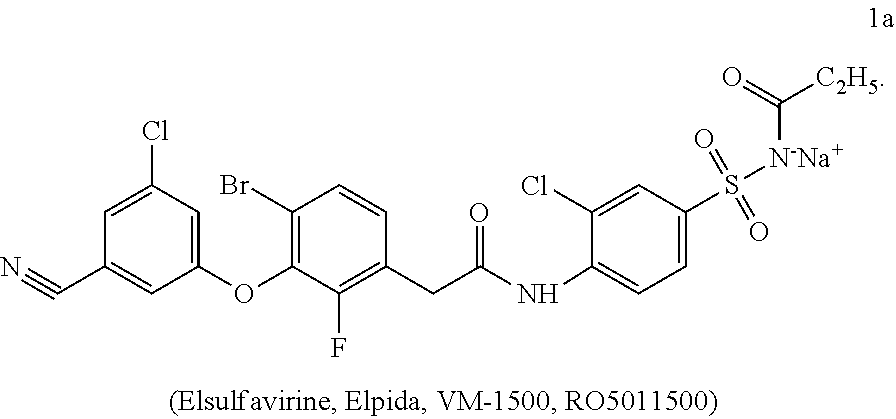Combined medicinal preparation for treating viral infections
a combination medicine and virus technology, applied in the field of new combination drugs, can solve the problems of putting people at high risk of death from anti-hbv drugs are not widely accessible or used by hbv-infected people, and the risk of cirrhosis and liver cancer is a major global health problem, so as to increase the risk of hbv or hiv contamination, and increase the risk of contamination
- Summary
- Abstract
- Description
- Claims
- Application Information
AI Technical Summary
Benefits of technology
Problems solved by technology
Method used
Image
Examples
example 2
Evaluation of Anti-HIV Activity, Cytotoxicity, and Selectivity Index for Tenofovir of Formulas 4f, 4h, 4k, and 4m.
[0104]The anti-HIV activity of active ingredients (test compounds) was evaluated using SupT1 cells. The cells were infected with the NL4.3 HIV strain carrying a gene of green fluorescence protein (NL4.3-GFP). The virus preparation was obtained by transfection of 293T cells of proviral DNA. Forty-eight hours after the transfection, the preparation was frozen and stored until use. To enhance the infection efficiency, the suspension of SupT1 cells was precipitated from the infection mixture by centrifugation. Test compounds were added to the cells immediately before virus addition. After a 2-hour incubation, the infection mixture was replaced by fresh culture medium with test compounds. The infection efficiency was evaluated following 45 hours by counting the percent of fluorescing cells against noninfected cell cultures. The cytotoxicity of test compounds was evaluated sim...
example 3
Evaluation of Anti-HBV Activity, Cytotoxicity, and Selectivity Index for Tenofovirs of Formulas 4f, 4h, 4k, 4m.
[0105]Anti-HBV activity of tenofovir of formulas 4f, 4h, 4k, 4m (test compounds) was evaluated in the cell line of human hepatoma AD38 carrying integrated HBV DNA with terminal repeats [Lander S, et. al, Antimicrobial Agents and Chemotherapy, 1997, pp. 1715-1720]. The cell line was made available by Dr. C. Seeger, Fox Chase Cancer Center, Philadelphia, Pa.). Simultaneously, cytotoxicity was evaluated.
[0106]The cells were cultivated in complete DMEM / F12 culture medium containing 2 mM of L-glutamine (Thermo Scientific, Cat #11320033), 10% fetal bovine serum (ThermoFisher Scientific, Cat#), 1% antibiotic-antimycotic solution (ThermoFisher Scientific, Cat#15240096), and 0.3 μg / ml of tetracycline (Sigma, Cat # T7660-5G). The cells were seeded into 96-well Corning Biocoat plates (Corning, Cat # 356407) in 225 μl of complete medium without tetracycline, 20 000 cells per well. The ...
example 4
Evaluation of Acute Toxicity and Tolerated Toxic and Lethal Doses of SODFs.
[0115]Evaluation of SODF acute toxicity and tolerated toxic and lethal doses for single intragastric administration to male and female mice and rats. Evaluation was carried out for 24 male rats weighing 235-260 g and 28 female rats weighing 225-250 g as well as for 24 male mice weighing 21-25 g and 24 female mice weighing 20-24 g. All in all, there were 8 groups in each of the four categories. SODF was administered in the largest possible volume 10 ml / kg three times a day at a 40-minute interval. Prior to administration, SODFs were dispersed, then ground in a mortar and mixed with a 0.5% Tween 80 solution to obtain a suspension suitable for intragastric administration to animals at a dose of ≤10 ml / kg. Solutions for administration were always prepared on the day of administration. Prepared SODF suspensions were administered at the same time every day (within a deviation of maximum 4 hours). Prior to SODF admi...
PUM
| Property | Measurement | Unit |
|---|---|---|
| survival time | aaaaa | aaaaa |
| total mass | aaaaa | aaaaa |
| total mass | aaaaa | aaaaa |
Abstract
Description
Claims
Application Information
 Login to View More
Login to View More - R&D
- Intellectual Property
- Life Sciences
- Materials
- Tech Scout
- Unparalleled Data Quality
- Higher Quality Content
- 60% Fewer Hallucinations
Browse by: Latest US Patents, China's latest patents, Technical Efficacy Thesaurus, Application Domain, Technology Topic, Popular Technical Reports.
© 2025 PatSnap. All rights reserved.Legal|Privacy policy|Modern Slavery Act Transparency Statement|Sitemap|About US| Contact US: help@patsnap.com



